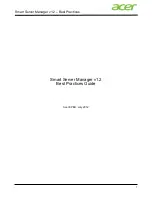
ExtremeWare XOS 11.0 Command Reference Guide
603
15
IP Unicast Commands
Extreme Networks switches provide full layer 3, IP unicast routing. They exchange routing information
with other routers on the network using either the Routing Information Protocol (RIP) or the Open
Shortest Path First (OSPF) protocol. The switches dynamically build and maintain routing tables and
determine the best path for each of its routes.
Each host that uses the IP unicast routing functionality of the switch must have a unique IP address
assigned. In addition, the default gateway assigned to the host must be the IP address of the router
interface.
The routing software and hardware directs IP traffic between router interfaces. A router interface is
simply a VLAN that has an IP address assigned to it.
As you create VLANs with IP addresses belonging to different IP subnets, you can also choose to route
between the VLANs. The VLAN switching and IP routing functions occur within the switch.
Each IP address and mask assigned to a VLAN must represent a unique IP subnet. You cannot
configure the same IP subnet on different VLANs.
The Extreme Networks switch maintains an IP routing table for network routes and host routes. The
table is populated from the following sources:
•
Dynamically, by way of routing protocol packets or by ICMP redirects exchanged with other routers
•
Statically, by way of routes entered by the administrator
—
Default routes, configured by the administrator
—
Locally, by way of interface addresses assigned to the system
—
By other static routes, as configured by the administrator
Dynamic routes are typically learned by way of RIP or OSPF. Routers that use RIP or OSPF exchange
information in their routing tables in the form of advertisements. Using dynamic routes, the routing
table contains only networks that are reachable.
Dynamic routes are aged out of the table when an update for the network is not received for a period of
time, as determined by the routing protocol.
Static routes are manually entered into the routing table. Static routes are used to reach networks not
advertised by routers. You can configure up to 64 static unicast routes on the switch.
Static routes can also be used for security reasons, to control which routes you want advertised by the
router. Static routes are never aged out of the routing table.
Summary of Contents for ExtremeWare XOS 11.0
Page 26: ...26 ExtremeWare XOS 11 0 Command Reference Guide Contents...
Page 176: ...176 ExtremeWare XOS 11 0 Command Reference Guide Commands for Managing the Switch...
Page 262: ...262 ExtremeWare XOS 11 0 Command Reference Guide VLAN Commands...
Page 280: ...280 ExtremeWare XOS 11 0 Command Reference Guide FDB Commands...
Page 492: ...492 ExtremeWare XOS 11 0 Command Reference Guide EAPS Commands...
Page 536: ...536 ExtremeWare XOS 11 0 Command Reference Guide STP Commands...
Page 580: ...580 ExtremeWare XOS 11 0 Command Reference Guide ESRP Commands...
Page 876: ...876 ExtremeWare XOS 11 0 Command Reference Guide BGP Commands...
Page 926: ...926 ExtremeWare XOS 11 0 Command Reference Guide IP Multicast Commands...
















































